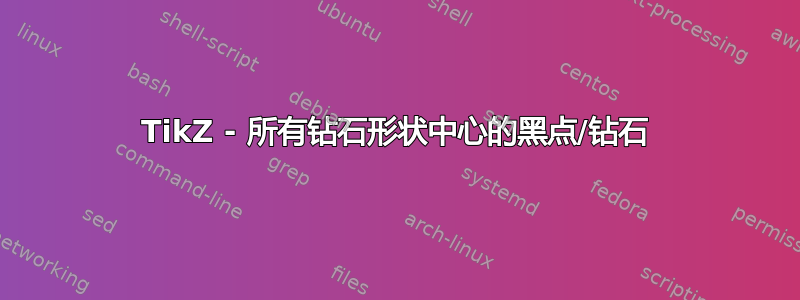
我正在制作流程图,在独立的 TikZ 文件中一切看起来都很好,但当我将其用于\input我的论文时,所有菱形在形状的正中央都有一个小黑菱形。无论节点中是否有文本,都会发生这种情况。由于我的论文模板,很难包含一个工作示例,但其他一切看起来都一样。
知道是什么原因造成中心出现这些小钻石吗?
\usetikzlibrary{shapes.misc,arrows, positioning}
\tikzstyle{startstop} = [draw, rectangle, rounded corners, top color=white, bottom color=red!30]
\tikzstyle{process} = [draw, rectangle, align=center, top color=white, bottom color=blue!30]
\tikzstyle{decision} = [draw, diamond, aspect=2, align=center, top color=white, bottom color=green!30]
\tikzstyle{arrow} = [thick,->,>=stealth]
\begin{tikzpicture}
\node (start) [startstop] {start};
\node (plf) [below=of start, process] {text \\ text};
\node (3) [below=of plf, decision] {text \\ $||$ \\ text};
\node (4) [below=of 3, process] {text $\pm$ 1};
\node (5) [below=of 4, process] {text \\ text};
\node (6) [below=of 5, process] {text \\ text};
\node (7) [below=of 6, process] {text};
\node (empty1) [right=of 3] {};
\node (9) [right=of empty1, decision] {text \\ text};
\node (10) [below=of 9, process] {text \\ text};
\node (stop) [below=of 10, startstop] {stop};
\node[coordinate] (12) [left=of 3] {};
\node[coordinate] (13) [right=of 9] {};
\draw [arrow] (start) -- (plf);
\draw [arrow] (plf) -- (3);
\draw [arrow] (3) -- node[anchor=west] {no} (4);
\draw [arrow] (4) -- (5);
\draw [arrow] (5) -- (6);
\draw [arrow] (6) -- (7);
\draw [arrow] (7) -| (12) -- (3);
\draw [arrow] (3) -- node[anchor=south] {yes} (9);
\draw [arrow] (9) -- node[anchor=west] {no}(10);
\draw [arrow] (9) -- node[anchor=south] {yes} (13) |- (stop);
\draw [arrow] (10) -- (stop);
\end{tikzpicture}
答案1
您的问题的原因已在上面的评论中发现并描述萨姆卡特和成本加运费(感谢两位!)。此问题的临时解决方案可以是:
- 按照建议成本加运费在她的评论中
- 使用现有的 MWE 生成 pdf 文件,然后将其作为图像包含在您的文档中:
\includegraphics{<flowchart name>} - 而是
diamond使用不同的形状,例如signal与它有相似之处
对于最后一种可能性,MWE 可以是:
\documentclass[tikz,
border=3mm]{standalone}
\usepackage{circuitikz}% <-- makes trouble before
\usetikzlibrary{arrows, chains, quotes, positioning,
shapes.symbols}
\begin{document}
\begin{tikzpicture}[
node distance = 6mm and 12mm,
start chain = going below,% <-- new
base/.style = {draw, minimum width=4.5em, align=flush center, outer sep=0pt,
on chain},% <-- new
decision/.style = {shape=signal, base,% <-- new, replace diamond
signal to=west and east,
top color=white, bottom color=green!30},
process/.style = {shape=rectangle, base,
top color=white, bottom color=blue!30},
startstop/.style = {shape=rectangle, base,
rounded corners,
top color=white, bottom color=red!30},
arrow/.style = {thick, -stealth},
every join/.style = {arrow}
]
% left column
\node (start) [startstop] {start};
\node (plf) [process,join] {text \\ text};
\node (3) [decision,join] {text \\ $||$ \\ text};
\node (4) [process] {text $\pm$ 1};
\node (5) [process,join] {text \\ text};
\node (6) [process,join] {text \\ text};
\node (7) [process,join] {text};
% right column
\node (8) [decision,right=of 3] {text \\ text};
\node (9) [process] {text \\ text};
\node (stop) [startstop,join] {stop};
% auxiliary coordinates
\coordinate[left =of 3.west] (10);
\coordinate[right=of 8.east] (11);
% connection lines
\draw [arrow] (3) edge ["no"] (4)
(3) edge ["yes"] (8)
(8) edge ["no"] (9)
(8) to ["yes"] (11) |- (stop);
\draw [arrow] (7) -| (10) -- (3);
\end{tikzpicture}
\end{document}
在上面的 MWE 中,我还使用了 TikZ 库chains,quotes并通过它们的帮助使代码更简洁。我还将流程图元素样式定义移到了 TikZ 图片选项中。Iz 可以在其他地方定义为 而\tikzset{...}不是 obsolete tikzstyle。使用此代码获得的图像如下。



